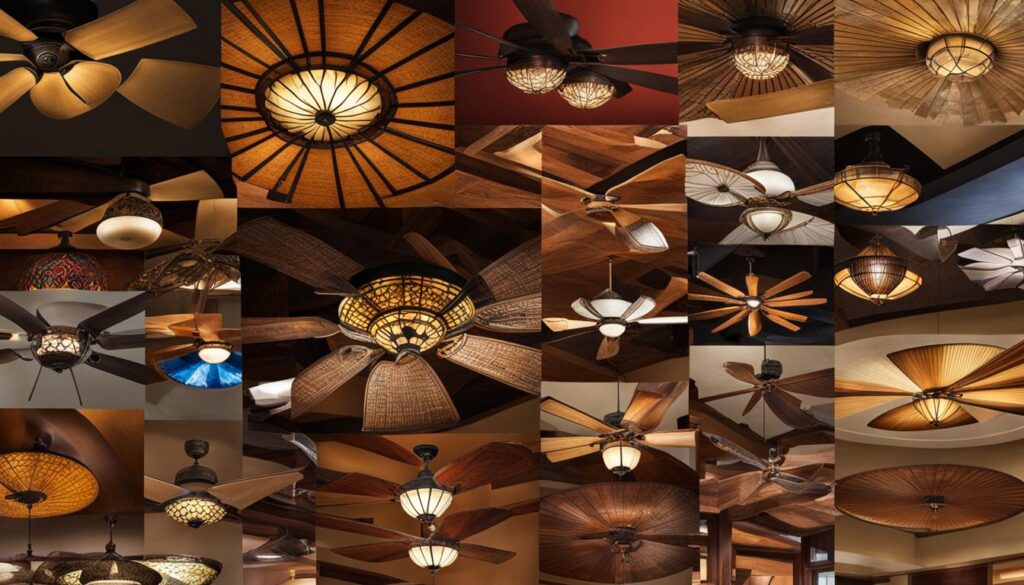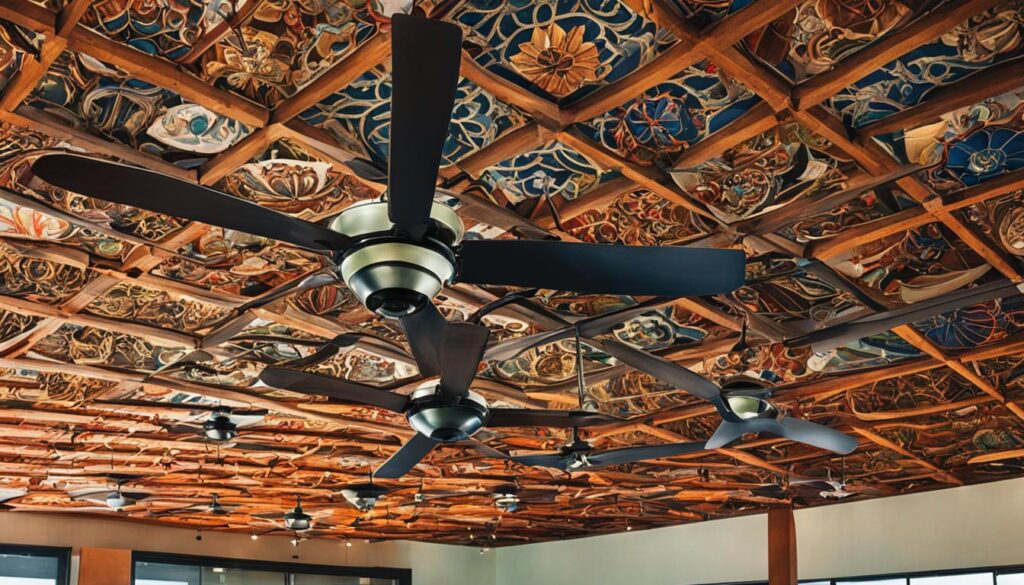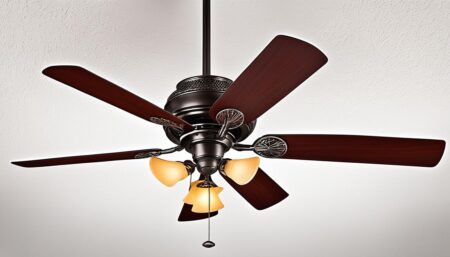Ceiling fans are a common feature in households around the world. However, the usage and cultural significance of ceiling fans vary across different cultures. For instance, in some cultures, ceiling fans are primarily used for cooling purposes, while in others, they hold symbolic importance. Understanding these cultural variations in ceiling fan usage can provide insights into the cultural practices, beliefs, and values of different societies.
Key Takeaways:
- Ceiling fan usage varies across cultures, reflecting cultural practices and beliefs.
- In some cultures, ceiling fans are considered a symbol of prosperity and good luck.
- Cultural factors such as climate and energy conservation influence ceiling fan usage patterns.
- Global variations exist, with different cultural contexts impacting ceiling fan usage.
- Cultural perspectives shape the importance and purpose of ceiling fans in different societies.
The Importance of Ceiling Fans in Different Cultural Contexts
In various cultures, ceiling fans hold significant importance beyond their functional use. In some cultures, ceiling fans are considered a symbol of prosperity and good luck. They are often adorned with decorative elements and intricate designs to enhance their aesthetic appeal.
“Ceiling fans are more than just a means to beat the heat; they represent prosperity and good fortune in our culture.”
In other cultures, ceiling fans are associated with religious rituals and ceremonies, where they are used to create a sense of calm and spiritual ambiance. The gentle rotation of the fan blades is believed to symbolize the flow of positive energy and create a harmonious environment.
Cultural Practices with Ceiling Fans:
- Decorating ceiling fans with vibrant colors and patterns to match the cultural aesthetics.
- Placing ceiling fans in central areas of the home, such as the living room or dining room, to symbolize their cultural significance.
- Using ceiling fans during auspicious occasions and festivals as a way to invite positive energy and blessings into the space.
Understanding these cultural practices and beliefs can shed light on the deep-rooted cultural significance of ceiling fans in different contexts. It emphasizes the bond between functionality, aesthetics, spirituality, and cultural identity.
Cultural Factors Influencing Ceiling Fan Usage

Cultural factors have a significant impact on the way ceiling fans are used in different societies. Various elements, including climate, geographical location, and cultural norms, shape the preferences and practices related to ceiling fan usage.
In regions with hot and humid climates, where access to air conditioning may be limited or costly, ceiling fans serve as the primary means of keeping cool. These cultural variations in climate dictate the necessity and reliance on ceiling fans as a practical and affordable cooling method.
Furthermore, cultural norms surrounding energy conservation and sustainability influence the usage of ceiling fans. In certain societies, there is a strong emphasis on reducing energy consumption and ensuring environmental preservation. As a result, ceiling fans are preferred over more energy-intensive cooling alternatives such as air conditioning units. This cultural inclination towards energy efficiency drives the widespread use of ceiling fans in these cultures.
Exploring these cultural factors gives us valuable insights into the reasons behind the variations in ceiling fan usage across different cultures. By understanding the influence of climate, geography, and cultural norms, we can better appreciate how these cultural variations shape the usage patterns of ceiling fans globally.
Cross-cultural Trends in Ceiling Fan Usage
Alongside the influence of cultural factors, there are also cross-cultural trends in ceiling fan usage. These trends emerge when we examine the shared practices and preferences regarding ceiling fans across different cultures.
“Ceiling fans are embraced in cultures worldwide, offering both functional benefits and symbolizing cultural values and beliefs.”
Despite their functional purpose of providing airflow and cooling, ceiling fans often hold symbolic significance within various cultures. In some societies, the presence of a ceiling fan represents prosperity, good luck, or even spirituality. As a result, ceiling fans are often adorned with decorative elements, reflecting the cultural aesthetics and traditions of a particular society.
By analyzing these cross-cultural trends in ceiling fan usage, we gain a comprehensive understanding of how ceiling fans go beyond their practical function and become cultural symbols embedded in different societies.
Global Variations in Ceiling Fan Usage

Ceiling fans are a ubiquitous feature in households across the globe, but the ways in which they are used and their cultural significance vary significantly from one region to another.
In certain Asian countries, such as India and Thailand, ceiling fans play a prominent role in religious places, homes, and public spaces. They are often seen as an integral part of traditional customs and practices. For example, in temples, ceiling fans are believed to aid in maintaining a comfortable environment for worshipers during religious ceremonies.
On the other hand, in Western countries like the United States, ceiling fans are more commonly found in residential settings. They are valued for their practicality, as they provide a cost-effective means of cooling and air circulation. In addition, ceiling fans contribute to energy efficiency by reducing the reliance on air conditioning systems.
This global variation in ceiling fan usage can be attributed to a combination of cultural, geographical, and climatic factors. Cultural practices, traditions, and beliefs surrounding ceiling fans differ across different societies, influencing their usage patterns and significance.
To further illustrate these global variations in ceiling fan usage, let us take a look at the following table:
| Region | Usage Patterns | Cultural Significance |
|---|---|---|
| Asia (India) | Widely used in religious places and homes for cooling and symbolism | Symbolic importance in religious ceremonies and belief in promoting positive energy |
| Asia (Thailand) | Popular in religious spaces, houses, and public areas for maintaining comfort | Considered essential for religious rituals and viewed as a sign of prosperity |
| North America (United States) | Mainly found in residential settings for cooling and energy efficiency | Prized for energy-saving benefits and practicality |
As demonstrated in the table, these global variations in ceiling fan usage showcase the cultural preferences and practices that shape the way people interact with these appliances. Exploring such cross-cultural trends provides valuable insights into the diverse ways in which ceiling fans are used and valued around the world.
Cultural Perspectives on Ceiling Fan Usage

Different cultures have distinct perspectives on the usage of ceiling fans. These perspectives are shaped by cultural differences, practices, and beliefs, which influence the way individuals interact with and perceive ceiling fans.
In some cultures, ceiling fans are highly valued for their practical benefits. They are seen as essential appliances for maintaining indoor comfort. These cultures recognize the airflow and cooling capabilities of ceiling fans, making them an integral part of daily life. Ceiling fans provide a cost-effective and energy-efficient way to combat heat and humidity, making them a practical choice in these cultural contexts.
On the other hand, in cultures that place a greater emphasis on environmental sustainability and energy conservation, ceiling fans are viewed as an eco-friendly alternative to air conditioning. These cultures prioritize reducing energy consumption and minimizing the carbon footprint. By utilizing ceiling fans instead of air conditioning, they can achieve their goals of energy conservation while still enjoying the benefits of airflow and cooling.
“Ceiling fans are not only functional, but they also align with our cultural beliefs about environmental stewardship and sustainability. By using ceiling fans, we can stay cool without compromising the health of our planet.”
Cultural Differences in Ceiling Fan Usage:
To illustrate the cultural differences in ceiling fan usage, let’s compare two distinct cultural practices:
| Culture | Perception of Ceiling Fans | Usage Practices |
|---|---|---|
| Culture A | Practical Appliance | Used throughout the day to maintain a comfortable environment |
| Culture B | Eco-Friendly Alternative | Used as a sustainable cooling solution to reduce energy consumption |
In Culture A, ceiling fans are embraced for their practical benefits and are commonly used throughout the day to maintain a comfortable environment. In contrast, Culture B views ceiling fans as an eco-friendly alternative and uses them primarily to reduce energy consumption and support sustainability initiatives.
By examining these cultural perspectives on ceiling fan usage, we gain insights into the diverse attitudes, beliefs, and practices that shape the way individuals and communities interact with this essential household appliance.
Image: A ceiling fan in use, reflecting the cultural perspectives on ceiling fan usage
Conclusion
Cultural Variations in Ceiling Fan usage showcase the diverse ways in which different cultures embrace this indispensable cooling device. By delving into the cultural beliefs, practices, and factors that influence ceiling fan usage, we gain valuable insights into the cultural identity and values of societies around the world. From decorative elements to religious significance, ceiling fans have a significant impact on cultural practices and preferences. Exploring these cross-cultural trends helps us deepen our understanding of how people across various cultural contexts interact with and appreciate ceiling fans.
The usage of ceiling fans across cultures is not limited to mere functionality. It encompasses a more profound and multifaceted cultural perspective. For some cultures, ceiling fans symbolize prosperity and good luck, while for others, they create a serene and spiritual atmosphere during religious rituals. The way different cultures incorporate ceiling fans into their everyday lives reflects their unique cultural beliefs and practices.
Global variations in ceiling fan usage further exemplify the cultural diversity surrounding this ubiquitous appliance. In some countries, such as India and Thailand, ceiling fans are a common sight in sacred places, homes, and public spaces. Conversely, in Western countries like the United States, ceiling fans are prominent in residential settings, where they are favored for their cooling capabilities and energy efficiency. Recognizing these global variations grants us an opportunity to appreciate and embrace the cultural preferences and practices associated with ceiling fan usage.






